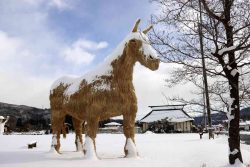Industrial Buildings in Old Days Make Optimal Spaces To Roast Coffee Beans in Kiyosumi-Shirakawa

The Cream of the Crop Coffee, a cafe with a large roasting machine located in a renovated warehouse in Koto Ward, Tokyo
6:00 JST, April 19, 2024
Known for its rich nature and classic atmosphere, Kiyosumi-shirakawa Station in Koto Ward, Tokyo, is a “desirable place to live,” with central Tokyo just a stone’s throw away. Also notable are its many coffee shops and cafes. While researching why those kinds of store were so concentrated in this area, I discovered that the effective revitalization of legacy industries has been key in the town’s contemporary development.
The area around the station has traditionally been called Fukagawa and was once a logistics hub for Edo, the old name for Tokyo.
The Onagi River, which runs from east to west of the ward, was originally constructed by Tokugawa Ieyasu, the first shogun of the Tokugawa shogunate who came to rule Edo in 1590. He built it to secure an inland waterway for shipping salt produced in Gyotoku, Chiba Prefecture, to Edo Castle, according to the historical records of Koto Ward.
In those days, fires were common. After a massive fire in 1641, the shogunate decided to concentrate lumber yards in a riverside area to secure materials for post-disaster reconstruction. The Fukagawa area was chosen for its convenient shipping route to central Edo via the river. Consequently, the lumber and sawmill industries flourished there.
“Because of the area’s flourishing lumber and sawmill industries, warehouses popped up everywhere. Nowadays lumber can be transported by truck, but before I went to elementary school, I often saw boatmen floating along the waterway transporting lumber that had been turned into rafts,” said Toshihiro Wakebe, 85, chairman of a local shopping area cooperative who has lived in the area for more than 80 years.
However, due to land subsidence and the installation of tide gates, transporting lumber on the river became increasingly difficult, and in the 1970s, all local lumber-related businesses moved to the Shin-kiba area. As freight transportation by land became mainstream, many warehouses were left unused and vacant. They would go on to become the town’s cafes.
The Cream of the Crop Coffee, a cafe opened in the Kiyosumi-shirakawa area in April 2012, is in a renovated lumber warehouse. It has a large coffee bean roasting facility with a roasting machine that reaches higher than 2 meters.
Hiroshi Teraoka, 59, an official of the company that runs the cafe, said: “We needed a building with a high ceiling to accommodate the large roasting machine. I’ve come to really like the Kiyosumi-shirakawa area, this former flourishing lumber yard. The lumber warehouse we use had few pillars and was a suitable candidate for renovation.”
Although the company initially considered opening cafes in Setagaya and Shinagawa wards, it was unable to find a suitable building with a high enough ceiling. There were also environmental concerns about the smoke that comes from the chimney during roasting.
Many other businesses in the industry similarly took note of the advantages of Fukagawa, including Allpress Espresso from New Zealand and Blue Bottle Coffee from the United States which opened their first stores in Japan in 2014 and 2015 respectively.
The town’s more than 20 stores are well known for being particular about where their coffee beans are grown and how they brew their coffee.
The Kiyosumi-shirakawa area promotes itself as a “town of art” in addition to being a town of coffee.
The Museum of Contemporary Art Tokyo opened in Kiba Park in the ward in 1995, and many galleries and studios have opened in the area since.
In recent years, the area’s many new coffee shops have created a “synergistic effect” of people enjoying coffee after enjoying art, Teraoka said. Many people take a train to Kiyosumi-shirakawa Station to visit the area.
“In the past, a lot of my friends would ask me, ‘Where is Kiyosumi-shirakawa?’ More recently, it’s quickly recognized as a fashionable town. We are getting more and more residents and foreign tourists,” said Takayuki Shiina, 46, who for about 10 years has run Glass-Lab Co., a producer and seller of traditional Edo kiriko cut glass products.
Shiina has planned events, such as a walking tour, to promote the area to locals. He is also involved in a business that provides shared office space to young people moving into the popular area.
“I’ll keep working hard to expand the popularity of the town and make it more interesting by using coffee and art and involving a variety of people,” he said.
◇◇◇

Related Tags
"Features" POPULAR ARTICLE
-

Autumn Foliage Reaches Peak Season at Korankei in Aichi Prefecture
-

Japan’s Osechi Meals See More Value Offerings as Customers Struggle with Rising Prices
-

Legendary Sushi Chef Jiro Ono Turns 100: ‘I Have No Regrets’
-

Autumn Foliage Surrounds Visitors to Tokyo’s Showa Kinen Park
-

Japanese, Western Flavors Blend in Satoimo Taro Cheese Dumplings; Versatile Seasonal Staple Served with Savory Sauce
JN ACCESS RANKING
-

Govt Plans to Urge Municipalities to Help Residents Cope with Rising Prices
-

Japan Resumes Scallop Exports to China
-

Japan Prime Minister Takaichi Vows to Have Country Exit Deflation, Closely Monitor Economic Indicators
-

Japan to Charge Foreigners More for Residence Permits, Looking to Align with Western Countries
-

Japan GDP Down Annualized 1.8% in July-Sept.
























